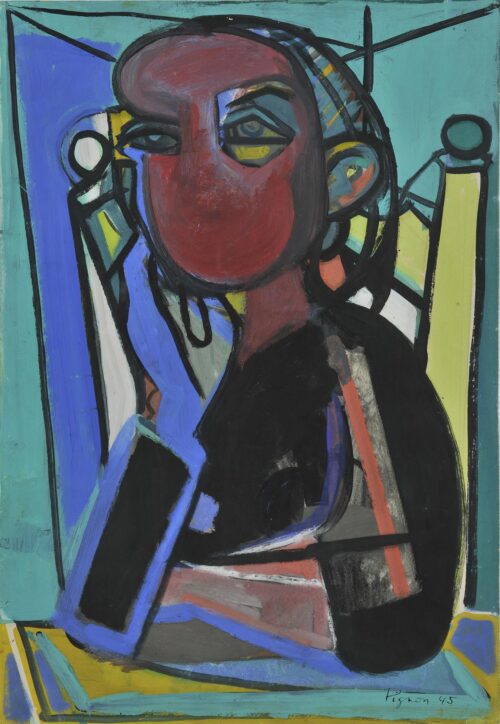
Pignon Edouard (1905 - 1993)
Composition with Face, 1945
He was the son of a coal miner and was born in a mining region. He settled in Paris in 1927 and worked in an automobile factory for Renault Citroen, while at the same time taking night classes in painting and sculpture.
In 1931 he joined the Union of Revolutionary Painters and Writers where he met Louis Aragon, Andre Malraux, Fernand Leger, Jean Helion and Francis Gruber.
His production of personal work began two years later. In 1936 he met Picasso and the following year the exhibition of Guernica at the International Exhibition of Paris would make a strong impression on him and influence his work.
During the Nazi occupation he became deeply involved in the Resistance in the National Front of the Arts. In May 1941 he exhibited with a group of 20 artists at the Braun Gallery. The strong colors which dominated their works and the practically abstract nature of the compositions were an open provocation to the conqueror. After the Liberation these artists became known as the post-war School of Paris.
His first solo exhibition was held in 1939 and was presented by Gromaire; it was followed by many others.
Starting in 1947 he began to dissociate himself from Socialist Realism which had been adopted by the Communist Party, and at the same time took a stance against painting which had begun to dominate French painting.
In 1951 Picasso suggested they work together to the produce of pottery at Valloriz, keeping him busy for the next two years, at the same continuing with a series of works. Oliviers and Paysans. During the period of his cooperative endeavors with Picasso, he also started the series Maternites and L’ Homme a l’ Enfant.
The subject matter of his works was influenced by his political activity in the service of which he had placed his work. At the end of the Sixties he was involved with the subject of war, though later he turned toward nature. He was involved with stage and costume design and the making monumental sculptural works of day.
He adopted a variety of technique, while in the closing years of his life he turned almost exclusively to water-colors. Though he considered abstract painting to be a denial of reality, in his later work there are many abstract elements. His work occupies an important place in post-war-French painting.

Composition with Face, 1945

We use cookies to make our site work properly, to personalize content and ads, to provide social media features and to analyze our traffic. We also share information about how you use our site with our social media, advertising and analytics partners. Read the Cookies Policy.
These cookies are necessary for the website to function and cannot be switched off in our systems. They are usually only set in response to actions made by you which amount to a request for services, such as setting your privacy preferences, logging in or filling in forms. You can set your browser to block or alert you about these cookies, but some parts of the site will not then work. These cookies do not store any personally identifiable information.
If you disable this cookie, we will not be able to save your preferences. This means that every time you visit this website you will need to enable or disable cookies again.
These cookies tell us about how you use the site and they help us to make it better. For example these cookies count the number of visitors to our website and see how visitors move around when they are using it. This helps us to improve the way our site works, for example, by ensuring that users find what they are looking for easily. Our website uses Google Analytics for statistics reporting.
Please enable Strictly Necessary Cookies first so that we can save your preferences!